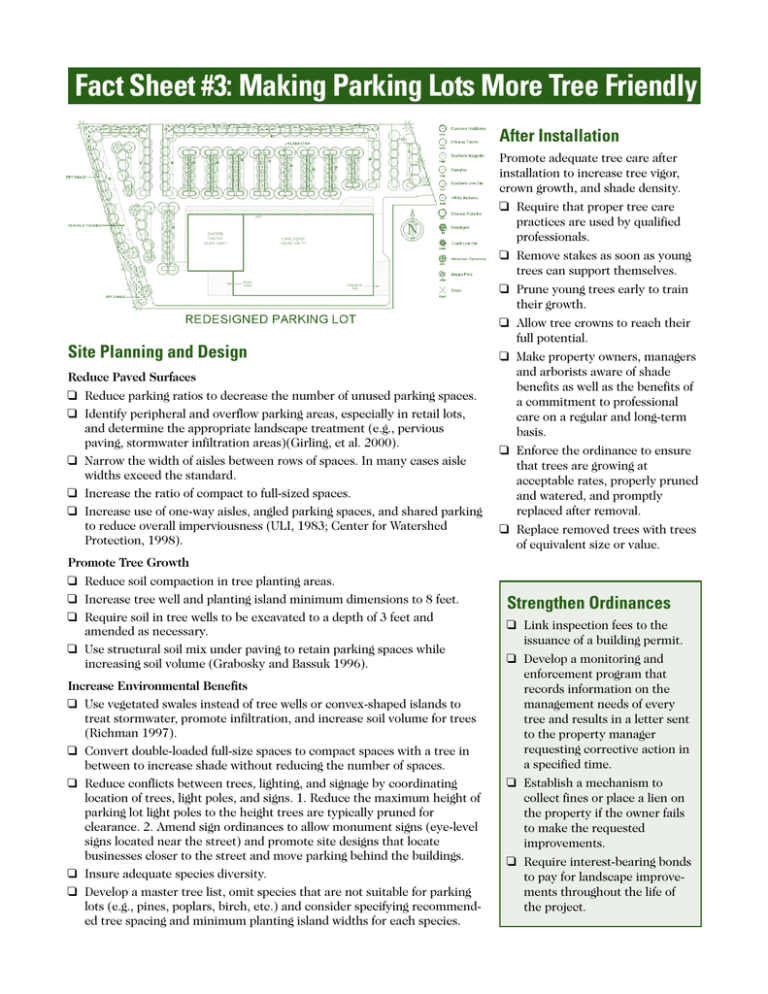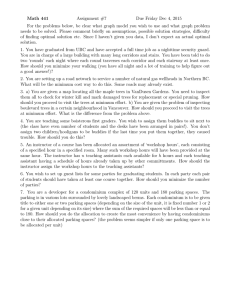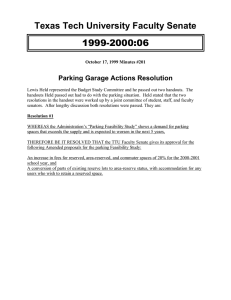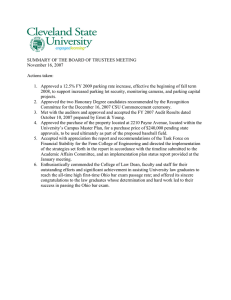Fact Sheet #3: Making Parking Lots More Tree Friendly After Installation
advertisement

Fact Sheet #3: Making Parking Lots More Tree Friendly After Installation Site Planning and Design Reduce Paved Surfaces K Reduce parking ratios to decrease the number of unused parking spaces. K Identify peripheral and overflow parking areas, especially in retail lots, and determine the appropriate landscape treatment (e.g., pervious paving, stormwater infiltration areas)(Girling, et al. 2000). K Narrow the width of aisles between rows of spaces. In many cases aisle widths exceed the standard. K Increase the ratio of compact to full-sized spaces. K Increase use of one-way aisles, angled parking spaces, and shared parking to reduce overall imperviousness (ULI, 1983; Center for Watershed Protection, 1998). Promote Tree Growth K Reduce soil compaction in tree planting areas. K Increase tree well and planting island minimum dimensions to 8 feet. K Require soil in tree wells to be excavated to a depth of 3 feet and amended as necessary. K Use structural soil mix under paving to retain parking spaces while increasing soil volume (Grabosky and Bassuk 1996). Increase Environmental Benefits K Use vegetated swales instead of tree wells or convex-shaped islands to treat stormwater, promote infiltration, and increase soil volume for trees (Richman 1997). K Convert double-loaded full-size spaces to compact spaces with a tree in between to increase shade without reducing the number of spaces. K Reduce conflicts between trees, lighting, and signage by coordinating location of trees, light poles, and signs. 1. Reduce the maximum height of parking lot light poles to the height trees are typically pruned for clearance. 2. Amend sign ordinances to allow monument signs (eye-level signs located near the street) and promote site designs that locate businesses closer to the street and move parking behind the buildings. K Insure adequate species diversity. K Develop a master tree list, omit species that are not suitable for parking lots (e.g., pines, poplars, birch, etc.) and consider specifying recommended tree spacing and minimum planting island widths for each species. January 2002 Promote adequate tree care after installation to increase tree vigor, crown growth, and shade density. K Require that proper tree care practices are used by qualified professionals. K Remove stakes as soon as young trees can support themselves. K Prune young trees early to train their growth. K Allow tree crowns to reach their full potential. K Make property owners, managers and arborists aware of shade benefits as well as the benefits of a commitment to professional care on a regular and long-term basis. K Enforce the ordinance to ensure that trees are growing at acceptable rates, properly pruned and watered, and promptly replaced after removal. K Replace removed trees with trees of equivalent size or value. Strengthen Ordinances K Link inspection fees to the issuance of a building permit. K Develop a monitoring and enforcement program that records information on the management needs of every tree and results in a letter sent to the property manager requesting corrective action in a specified time. K Establish a mechanism to collect fines or place a lien on the property if the owner fails to make the requested improvements. K Require interest-bearing bonds to pay for landscape improvements throughout the life of the project. Urban Forest Research References: Making Parking Lots More Tree Friendly For more information on parking lots, refer to the following publications written by Center researchers and associates: Center for Watershed Protection. 1998. Better site design: a handbook for changing development rules in your community. Center for Watershed Protection. Ellicott City, MD. 174 p. McPherson, E.G. 2001. Sacramento's parking lot shading ordinance: environmental and economic costs of compliance. Landscape and Urban Planning 57:105–123. Girling, C.; Kellett, R.; Rochefort, J.; Roe, C. 2000. Green neighborhoods: planning and design guidelines for air, water, and urban forest quality. Center for Housing Innovation. University of Oregon, Eugene. 132 p. McPherson, E.G.; Simpson, J.R.; Scott, K.I. 2000. Actualizing microclimate and air quality benefits with parking lot tree shade ordinances. Wetter und Leben. 50: 353–369. Grabosky, J.; Bassuk, N. 1996. Testing of structural urban tree soil materials for use under pavement to increase street tree rooting volumes. J. Arbor. 22: 255– 262. Richman, T. 1997. Start at the source: residential site planning and design guidance manual for stormwater quality protection. Bay Area Stormwater Management Agencies Association. Oakland, CA. 75 p. Increasing Effectiveness in Parking Lots It is necessary to make key planning decisions prior to starting the retrofitting process. Some actions need to be taken and others avoided. Consider the following during the planning phase: k Avoid double-counting tree shade where tree shade overlaps. k Do not allow planting of trees not on the ordinance’s Recommended Tree List. Improve the Tree List if necessary. k Be sure crown diameters on parking lot plans correctly reflect crown diameters specified in the Tree List. Scott, K.I.; Simpson, J.R.; McPherson, E.G. 1999. Effects of tree cover on parking lot microclimate and vehicle emissions. J. Arbor. 25: 129–141. Scott, K.I.; Simpson, J.R.; McPherson, E.G. 1999. Green parking lots: can trees improve air quality? In McPherson, E.G.; Mathis, S., editors. Proceedings of the best of the west summit. CAES. University of California, Davis, Davis, CA; 86–87. Urban Land Institute. 1983. Shared parking. Urban Land Institute, Washington, D.C. 86 p. k Be sure crown diameters for mature trees are not overstated in the Tree List, thus allowing parking lot plans to reflect more shade than they can actually achieve. Correct diameters in the List if necessary. k Follow-up to ensure trees are actually planted, as well as not removed shortly after planting, especially at sites near store fronts where trees could obstruct signs. k Do not allow smaller-sized substitutions after the plans have been approved. k Do not allow parking lot ratios to exceed those stipulated in the ordinance. Visit our website at http://cufr.ucdavis.edu This fact sheet is provided for you to copy and distribute. Please credit the Center for Urban Forest Research, Pacific Southwest Research Station,Forest USDA Forest Service, Davis, California. January 2002. Urban Research January 2002



